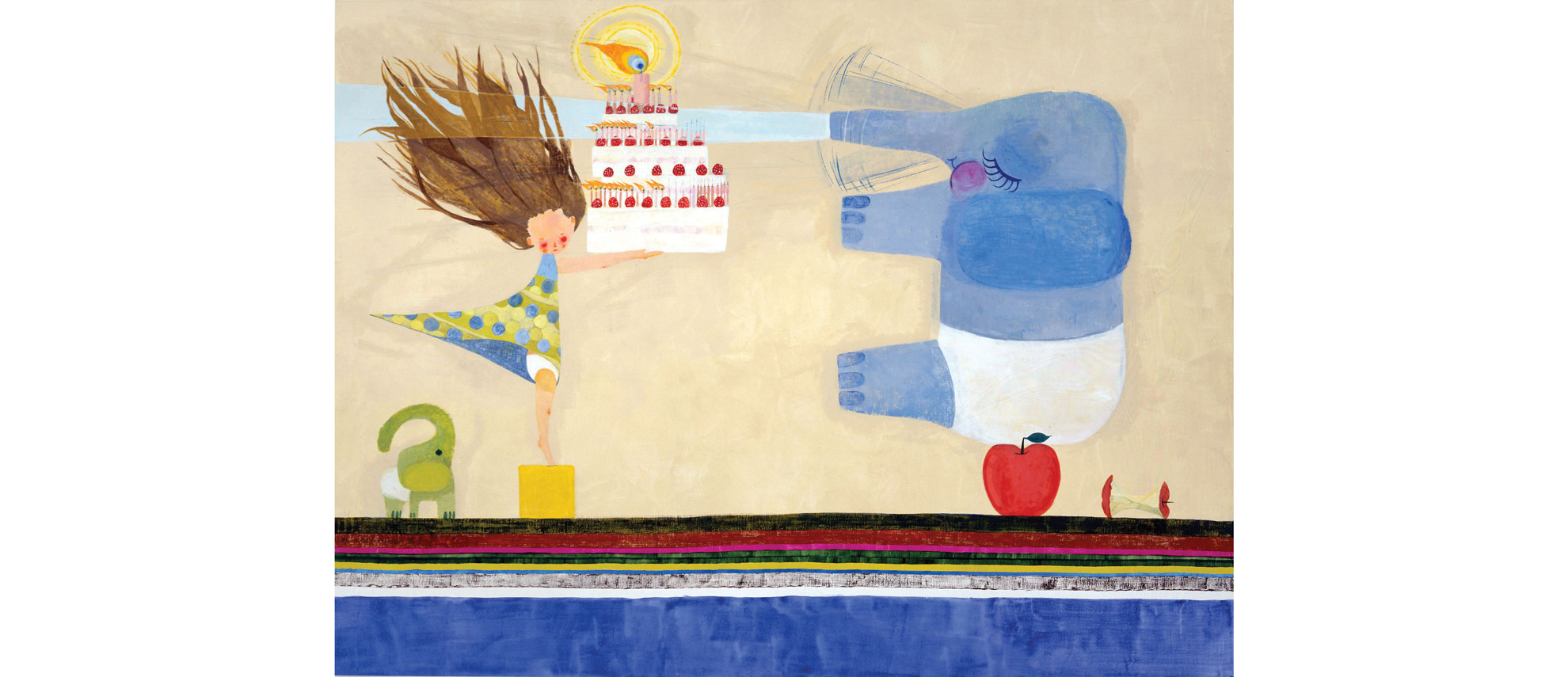FOCUS: Chinatsu Ban

Chinatsu Ban
Happy Birthday, 2003
Acrylic on canvas
76 3/8 x 102 inches
Courtesy Tomio Koyama Gallery, Tokyo
©2003 Chinatsu Ban/Kaikai Kiki Co., Ltd.
All Rights Reserved.
The Japanese artist Chinatsu Ban creates imaginative narratives using a recurring cast of figures, primarily little girls and elephants, and objects, such as apples and ice cream, in her drawings and large-scale acrylic paintings, which initially suggest the whimsy of children’s book illustrations. Since the artist’s childhood, the elephant, which is now her central motif, has been a source of comfort. “Though I am not religious, I have strong native-Japanese Shinto beliefs,” Ban explains, “and for centuries the Japanese have believed in mysterious powers that surpass human ability, which are celebrated as kami (deities). Kami can be mountains, stones, or even water. . . . In my case, there was a time when elephants protected me. When I am gripped with fears from my past, I calm myself by focusing on one thing.
Ban combines personal symbolism with Japanese artistic traditions and aspects of contemporary pop culture in her work. She cites the formal characteristics of the Edo period in Japanese art (1615–1868) as influences on her style of using bright colors and simplified forms. In particular, she is drawn to the period’s reductive, flattened space and decorative surfaces. Edo, the original name for Tokyo, is known as an urban movement at a time when Tokyo was the largest city in the world. The period is marked by its rise in both leisure and industry and its class differentiation and increased flow of money. Modern Tokyo, with its mix of enterprise, brash youth culture, and simultaneous firm ties to tradition, is said to be born of the Edo period. As a young artist working in Tokyo, Ban understandably is immersed not only in contemporary pop culture, but also the tradition to which it connects.
In fact, like other Japanese artists of her generation, Ban’s content and style is informed by the pictorial language of the kawaii (cute) culture, a faction of pop culture. Kawaii became pervasive in Japan in the 1970s, when commercial objects featuring characters such as Sanrio’s well-known Hello Kitty were first introduced. The influence of the kawaii aesthetic can be seen in many aspects of contemporary Japanese culture, from food presentation to entertainment and fashion, and is now globalized in visual media such as anime (animation) and manga (comic books). Ban’s use of the elephant exemplifies the kawaii aesthetic. Like Hello Kitty, Ban’s elephant is cartoon-like, with some features exaggerated, like its large trunk and head, and others simplified, like its mouth, which ranges from a simple line to nothing at all. Ban’s typical elephant is also docile and delicate despite its size. In 2005 she made her first fiberglass sculptures of elephants, which bring to mind oversized piggybanks. Even the piles of dung shown behind them are made to look like accessories for a toy. Cheerfully multicolored, they are suggestive of candy or dollops of ice cream.
The specific kawaii theme of creating characters who assume the clothing and mannerisms of young girls is also prevalent in Ban’s imagery. She often portrays young girls and elephants at play, wearing bloomers and underpants, in works that have been characterized as “obsessively cute.” Yet rather than using the cute aesthetic in a straightforward manner, Ban’s imagery might be seen as a critique of the aaulture and an allusion to its complexities: Her elephants derive their unmistakable cuteness from the fact that they are infantile and objectified, and in this way they parallel kawaii depictions of women, who are commonly presented as innocent and childlike.
Undercurrents of fear, the sexual impulses of childhood, and adult sexuality are also present in Ban’s imagery. Exceedingly cute, patterned girls’ underpants—a universal symbol of innocence and virginity—specifically relate to the artist’s earliest experiences with body awareness and become part of the personal symbolism apparent in her work. Ban’s imagery, in an understated way, represents the dark side of kawaii, in which young girls are often center stage in a sexually charged environment.
FOCUS: Chinatsu Ban, the artist’s first solo museum exhibition, comprises two small-scale sculptures of elephants and three newly created large-scale paintings. The paintings represent a new phase of Ban’s imagery in which significant stylistic and conceptual changes begin to take place: the elephant is more abstracted, and other common motifs, such as underpants, are no longer obviously part of her major thematic concerns. Instead, the landscape is increasingly more mythical and epic, and metaphor is derived from nature rather than from culturally produced objects.
Ban’s work has been included in two major group exhibitions that recognize emerging Japanese artists: Little Boy: The Arts of Japan’s Exploding Subculture and Tokyo Girls Bravo, both organized by the influential Japanese artist Takashi Murakami. Ban is also part of Kaikai Kiki Co., Ltd., an art production company founded by Murakami. With offices in New York and Tokyo, Kaikai Kiki maintains, manages, and promotes a select number of Japanese artists and produces animation and art-related merchandise.
Chinatsu Ban
Happy Birthday, 2003
Acrylic on canvas
76 3/8 x 102 inches
Courtesy Tomio Koyama Gallery, Tokyo
©2003 Chinatsu Ban/Kaikai Kiki Co., Ltd.
All Rights Reserved.
